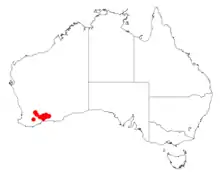| Acacia quinquenervia | |
|---|---|
| Scientific classification | |
| Kingdom: | Plantae |
| Clade: | Tracheophytes |
| Clade: | Angiosperms |
| Clade: | Eudicots |
| Clade: | Rosids |
| Order: | Fabales |
| Family: | Fabaceae |
| Subfamily: | Caesalpinioideae |
| Clade: | Mimosoid clade |
| Genus: | Acacia |
| Species: | A. quinquenervia |
| Binomial name | |
| Acacia quinquenervia | |
 | |
| Occurrence data from AVH | |
Acacia quinquenervia is a shrub of the genus Acacia and the subgenus Phyllodineae that is endemic to south western Australia
Description
The shrub typically grows to a height of 0.2 to 1.5 metres (0.7 to 4.9 ft) with peeling and fibrous bark.[1] The branchelts are usually densely haired and like most species of Acacia it has phyllodes rather than true leaves. The green to grey-green phyllodes are flat with a narrowly linear shape with a length of 2 to 7 cm (0.79 to 2.76 in) and a width of 1 to 2 mm (0.039 to 0.079 in) with five noticeable nerves. The rudimentary inflorescences appear on two branched racemes with spherical flower-heads that have a diameter of 3.5 to 4 mm (0.14 to 0.16 in) and contain 15 to 20 light golden coloured flowers. The linear and biconvex seed pods that form after flowering are shallowly curved and have a length up to around 5.5 cm (2.2 in) and a width of 1.5 to 3 m (4 ft 11 in to 9 ft 10 in). The thinly coriaceous-crustaceous seed pods are glabrous to moderately hairy with longitudinally arranged seeds inside. The mottled seeds have an oblong shape with a length of 2.5 to 3 mm (0.098 to 0.118 in) and a terminal conical shaped aril.[2]
Taxonomy
The species was first formally described by the botanist Bruce Maslin in 1999 as part of the work Acacia miscellany. The taxonomy of fifty-five species of Acacia, primarily Western Australian, in section Phyllodineae (Leguminosae: Mimosoideae) as published in the journal Nuytsia. It was reclassified as Racosperma quinquenervium by Leslie Pedley in 2003 then transferred back to genus Acacia in 2006.[3] The specific epithet (quinquenervia) is from the Latin quinque meaning "five" and nervus, "vein", referring to the leaves usually having five veins.[4]
Distribution
It is native to an area in the Wheatbelt and Goldfields-Esperance regions of Western Australia where it is commonly situated on flats and undulating plains growing in sandy, clay or loamy soils.[1] It has a scattered distribution from around Nyabing in the south west to around Peak Charles National Park in the north east where it is usually a part of low Eucalyptus woodlands or open mallee shrubland communities.[2]
See also
References
- 1 2 "Acacia quinquenervia". FloraBase. Western Australian Government Department of Biodiversity, Conservation and Attractions.
- 1 2 "Acacia quinquenervia". World Wide Wattle. Western Australian Herbarium. Retrieved 2 August 2020.
- ↑ "Acacia quinquenervia Maslin". Atlas of Living Australia. Global Biodiversity Information Facility. Retrieved 2 August 2020.
- ↑ Wrigley, John W.; Fagg, Murray (1993). Bottlebrushes, paperbarks & tea trees, and all other plants in the Leptospermum alliance. Pymble, N.S.W.: Angus & Robertson. p. 297. ISBN 0207168679.